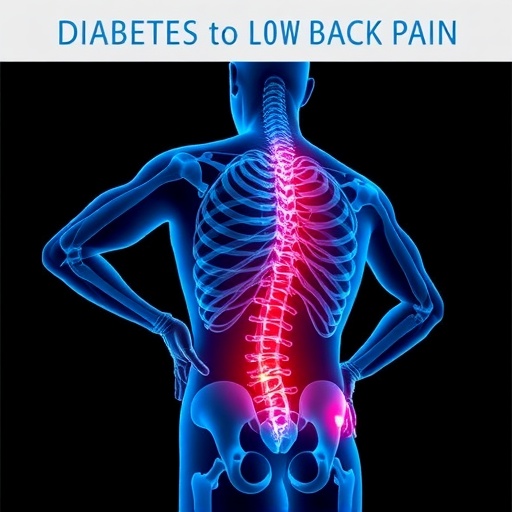The intersection of diabetes and low back pain is an increasingly significant focus in medical research, particularly as populations age and lifestyle-related diseases become more prevalent. A recent systematic review and meta-analysis has shed light on this connection, providing critical insights into the prevalence of diabetes among individuals suffering from low back pain, as well as the underlying risk factors contributing to both conditions. This comprehensive study emphasizes the need for healthcare professionals to consider the multifaceted nature of chronic pain and metabolic disorders to enhance treatment outcomes.
The analysis, conducted by Deng, R., Zhang, M., Zhang, W., and colleagues, meticulously collated data from various studies examining the links between low back pain and diabetes. The urgency of understanding these connections is underscored by the sheer scale of both conditions—research estimates indicate that low back pain affects the majority of adults at some point in their lives, and diabetes cases continue to rise on a global scale, often fueled by lifestyle factors such as poor diet and sedentary behavior.
Chronic low back pain, often described as a debilitating condition, can drastically reduce a person’s quality of life, leading to decreased physical activity, weight gain, and subsequent metabolic disturbances. The study revealed concerning statistics; individuals with low back pain exhibited a significantly higher prevalence of diabetes compared to those without such pain. This correlation raises vital questions about whether managing low back pain effectively could play a role in mitigating the risk of developing diabetes among these patients.
Furthermore, the analysis delved into potential risk factors that might predispose individuals to both conditions. Factors such as obesity, age, sedentary lifestyle, and genetic predispositions were identified as commonalities between those suffering from low back pain and those diagnosed with diabetes. Particularly alarming is the role of inflammation, often present in both conditions, possibly serving as a common pathway that exacerbates both pain and glucose metabolism disorders.
Healthcare providers are encouraged to adopt a holistic approach when treating patients with low back pain, recognizing the potential of a multidisciplinary strategy that addresses both pain management and metabolic health. The findings suggest that integrated care programs, which include physical therapy, nutritional counseling, and lifestyle modifications, could effectively decrease the incidence of diabetes in patients struggling with chronic pain.
The implications of this research extend beyond individual health, touching upon public health strategies aimed at addressing the dual burden of these chronic conditions. Health systems must adapt to the growing need for preventive measures and robust management strategies to address the intertwined nature of chronic pain and diabetes. Preventative health programs focusing on exercise, education, and community support can provide meaningful benefits in reducing the risk of diabetes in populations with high rates of low back pain.
Moreover, access to healthcare and resources plays a critical role in managing these conditions effectively. Social determinants of health, including socioeconomic status, education, and access to medical facilities, can significantly influence both the prevalence and management of diabetes and low back pain. Tailoring health interventions to meet the needs of diverse populations can lead to better outcomes and reduced disparities in health equity.
The study concluded by advocating for further research to uncover more nuanced pathways linking low back pain and diabetes. By exploring additional variables such as mental health, dietary habits, and exercise patterns, researchers can contribute to a more detailed understanding of the mechanisms at play. This knowledge could ultimately lead to novel interventions and guidelines aimed at breaking the cycle of chronic pain and metabolic disease.
As the healthcare community continues to grapple with the complex relationships between various chronic conditions, the data presented in this study serve as a call to action. It underscores the importance of interprofessional collaboration among healthcare providers to develop comprehensive care strategies that treat both pain and its potential metabolic consequences.
With rising global prevalence rates of diabetes and an increasing recognition of the societal impact of chronic pain, this research contributes significantly to our understanding of how interconnected these health challenges are. As awareness grows, future initiatives must prioritize advancing education among practitioners about the links between these prevalent conditions, potentially leading to improved health outcomes for millions of individuals worldwide.
In summary, the systemic review and meta-analysis by Deng and colleagues illuminates the pressing need for clinicians and researchers alike to reimagine the relationship between low back pain and diabetes. This understanding not only advances clinical practice but also informs public health efforts aimed at improving quality of life and reducing the global burden of these two impactful health issues.
Subject of Research: The prevalence and risk factors of diabetes in people with low back pain.
Article Title: Prevalence and Risk Factors of Diabetes in People with Low Back Pain: a Systematic Review and Meta-Analysis.
Article References:
Deng, R., Zhang, M., Zhang, W. et al. Prevalence and Risk Factors of Diabetes in People with Low Back Pain: a Systematic Review and Meta-Analysis. Biochem Genet (2025). https://doi.org/10.1007/s10528-025-11207-y
Image Credits: AI Generated
DOI: 10.1007/s10528-025-11207-y
Keywords: diabetes, low back pain, prevalence, risk factors, systematic review, meta-analysis, metabolic health, chronic pain, interprofessional collaboration.




